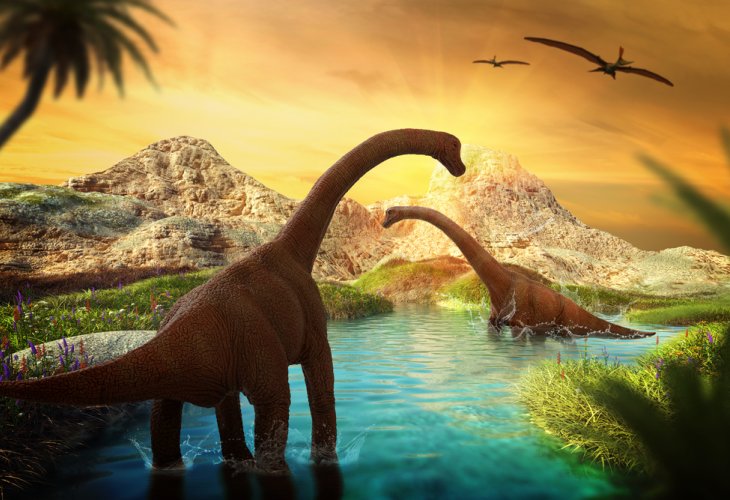Faith
Are Dinosaurs Mentioned in the Torah? Uncovering the Mystery of the “Great Sea Creatures”
Exploring the link between the Torah’s “great sea creatures” and the prehistoric giants we call dinosaurs
 (Photo: Shutterstock)
(Photo: Shutterstock)In a previous article, we explored whether all dinosaurs truly went extinct. We now address what the Torah says about their creation.
Thousands of dinosaur skeletons have been discovered to date. While some reconstructions remain debated, enough full skeletons and skulls have been unearthed to confirm the existence of a massive family of ancient reptiles that once roamed the earth but are now extinct. Did the Torah explicitly record their creation?
In the first chapter of Bereishit, the Torah describes God creating every family of living creatures: fish, birds, cattle, creeping things, and so forth. However, the verses do not list individual species such as ants, ravens, cows, or horses.
One verse, however, stands out as unique: “And God created the great sea creatures [tanninim gedolim]” (Bereishit 1:21).
The Hebrew word tannin generally refers to the large and dangerous reptile we know today as the crocodile, an animal well known in ancient Egypt along the Nile.
The crocodile is often seen as one of the last surviving remnants of the dinosaur age and remains the largest reptile on earth today, with some reaching lengths of seven meters or more. Certainly, a crocodile qualifies as “large,” but the Torah does not simply state, “God created the tanninim” but specifies “the great tanninim”—emphasizing their massive size. In no other verse does the Torah highlight the size of animals.
If today’s crocodile already appears “great” to us, the Torah must be pointing to creatures of far greater size — giant reptiles of staggering dimensions. In plain terms, what we now call “dinosaurs” (from the Greek, meaning “terrible lizards”) seem to have been clearly referenced in the Torah, written over 3,300 years ago.
Notice that the Torah does not say “the great elephants” or any other familiar animals, but singles out the tanninim, the giant reptiles. No human being at that time could have predicted that one day, paleontologists would discover enormous fossilized reptiles from prehistoric history.
From this perspective, the “great tanninim” can be understood as the family of dinosaurs, encompassing many different species on land and in the seas.
Tanninim, Snakes, and Leviathan
Another fascinating clue appears in Shemot, where Moshe's staff turns into a tannin (Shemot 7:9) and later into a “serpent” (nachash) (Shemot 7:15). Which was it? Rashi resolves this by stating: “It became a tannin — meaning a serpent.” This suggests that tannin may be a broader term referring to the reptile family, within which the snake is only one type (indeed, the primordial serpent is described as a creature with limbs before its curse).
The Midrash presents another interpretation: the “great tanninim” were Leviathans that later disappeared. Rashi comments: “The great tanninim — these are the great sea creatures. In the words of Aggadah, this refers to the Leviathan and its mate, which God created male and female. He killed the female and preserved her for the righteous in the future, for had they multiplied, the world could not endure them” (Bereishit 1:21).
This ancient Midrash teaches that these giant reptiles became extinct because they were unsuited for the human world.
The prophets also reference such primeval creatures. Yeshayahu (Isaiah) describes: “Leviathan the fleeing serpent, Leviathan the twisting serpent” (Yeshayahu 27:1). Since crocodiles (and other massive reptiles) are aquatic predators, the word “Leviathan” may have been applied because of their marine environment. The Shivtei Chachamim explains: “On land the tannin is called a snake, and in the water it is called a fish” (commentary to Shemot 7:9).
From this, we understand that the word tannin could encompass giant aquatic reptiles, possibly including marine dinosaurs.
Leviathan as a Symbol of Size
Another possible explanation relates to the size. The word “Leviathan” may have been used to describe the immense scale of these reptiles. Consider the Sauroposeidon, a dinosaur estimated to have stood 17 meters tall and stretched nearly 30 meters in length. Truly, only the image of a whale or Leviathan could capture such magnitude. Just as in our day we might call something huge “as big as an elephant,” the sages used Leviathan as a measure of grandeur.
Other Ancient Giants: The Re’em
The Sages also spoke of other giant primeval beasts under the name Re’em. A Midrash recounts David Hamelech (King David) climbing onto the back of one of the last Re’emim, mistaking it for a mountain, endangering his life (Midrash Tehillim, Buber edition, 22). The Talmud also discusses their size and how they fit on Noah’s Ark (Zevachim 113b).

